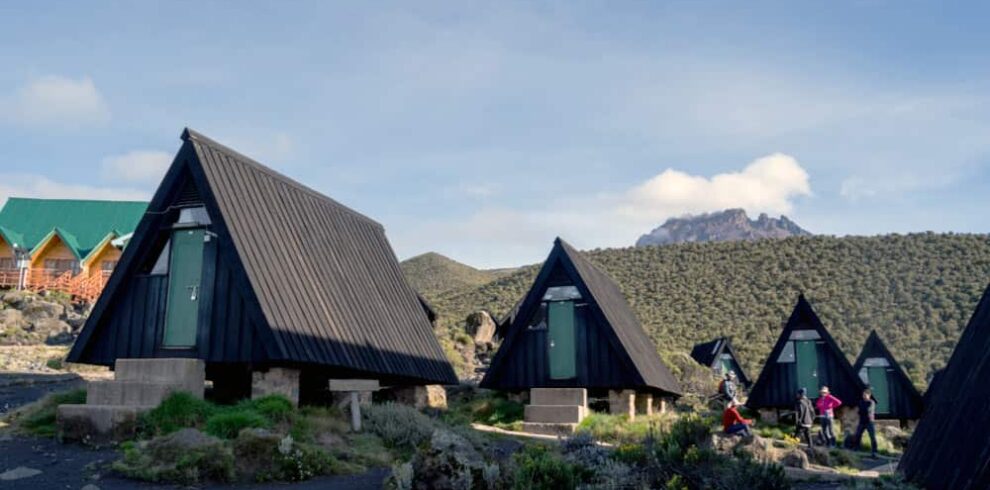Mount Kilimanjaro National Park
Kilimanjaro National Park is the proud home of Africa’s highest mountain, as well as the world’s highest free-standing mountain. Mount Kilimanjaro is composed of three volcanoes, namely Shira in the west, Mawenzi in the east, and the youngest of them all, Kibo, which stands at an impressive height of 5,895 meters. Shira and Mawenzi are now extinct, but Kibo is still dormant and could awaken at any moment.
The park boasts of an array of vegetation, with over 2,500 species of plants, including the endemic and stunning red and yellow impatiens kilimanjari and the colorful violet viola. The park’s lower regions are dominated by lush green montane forests, with almost 140 species of trees, while the moorland zone is graced with giant lobelias. Above 4,000 meters, you’ll find the moonlike desert, with not much growing and the land full of rocks and dust. Closer to the summit, hikers will be rewarded with beautiful sights of glaciers and a deep crater.
The park is also home to approximately 140 mammal species, 87 of which are forest dwellers. Some of the animals you’ll spot here include elephants, leopards, buffaloes, various antelopes such as the rare and endangered abbot duiker, as well as primates like the colobus and the mitis monkey. Additionally, 24 species of bats and 179 highland bird species have also been spotted in the Mount Kilimanjaro National Park.
Most visitors to the park are hikers, all with the same goal in mind – to make it to Africa’s highest peak. There are seven official routes to choose from, with Marangu being the easiest route for inexperienced hikers and those in search of a bit more comfort (overnights take place in huts). The Rongai route is the quietest and the best choice if you’re climbing in the rainy season, as this part of the mountain gets the least precipitation. Camping routes, including Lemosho, Shira, and Machame, are a bit more challenging but also much more scenic. The most demanding but also the least used route is Umbwe. Apart from Marangu and Rongai, all other routes descend on the Mweka route.
Above the rolling hills and plateaux of northern Tanzania rises the snowy peak of Mt. Kilimanjaro, its slopes and glaciers shimmering above the rising clouds. The mountain’s ecosystems are as strikingly beautiful as they are varied and diverse. On the lowland slopes, much of the mountain is farmland, with coffee, banana, cassava, and maize crops grown for subsistence and cash sale. A few larger coffee farms still exist on the lower slopes, but much of the area outside the national park has been subdivided into small plots. Once inside the park, thick lowland forest covers the lower altitudes and breaks into alpine meadows once the air begins to thin. Near the peak, the landscape is harsh and barren, with rocks and ice the predominant features above a breathtaking African view.
Climbing Mt. Kilimanjaro is the highlight of most visitors’ experiences in Tanzania. Few mountains can claim the grandeur, breathtaking views of Amboseli National Park in Kenya, the Rift Valley, and the Masaai Steppe, which belong to Kilimanjaro. Hiking on the “rooftop of Africa” – the highest point on the continent at 5,896 meters – is the adventure of a lifetime, especially because, if paced well, everyone from seasoned trekkers to first-time enthusiasts can scale the snowy peak. For more information, see the “Mountain Climbing” section under “Things to Do.”
Kilimanjaro is a name wreathed in mystery and clouds. It could mean “Mountain of Light,” “Mountain of Greatness,” or “Mountain of Caravans,” or it might not. The local people, the Wachagga, don’t even have a name for the whole massif, only Kipoo (now known as Kibo) for the familiar snowy peak that stands imperious, overseer of the continent, the summit of Africa. Kilimanjaro, by any name, is a metaphor for the compelling beauty of East Africa. When you see it, you understand why.
Mountain Trekking

Tanzania boasts some of the most diverse and stunning mountain landscapes globally, ranging from majestic volcanoes to dense forests teeming with rare wildlife. While climbing Mount Kilimanjaro is a dream for many, the adventure doesn’t end there. There are numerous other captivating mountain destinations in Tanzania awaiting exploration, whether for short day trips or extended multi-day hikes. It’s essential to check the latest park fees beforehand, as many of these mountains are located within protected national parks.
Climbing Kilimanjaro is a once-in-a-lifetime experience that tops bucket lists worldwide. Besides Kilimanjaro and Mount Meru, there are other options like the Crater Highlands. Trekking companies can tailor itineraries to your preferences, ensuring a well-prepared and enjoyable journey. Taking it slow and allowing your body to acclimatize, especially at higher altitudes, is advisable for a successful ascent.
With its breathtaking scenery, diverse vegetation, and unique cultural backgrounds, Tanzania offers a captivating mountain climbing experience for adventurers of all ages and fitness levels. From the towering Kilimanjaro to the challenging ascent of Ol Donyo Lengai, each mountain presents its own set of challenges and rewards. Whether you’re a seasoned mountaineer or a novice hiker, Tanzania’s mountains have something to offer everyone, promising an unforgettable adventure amidst nature’s grandeur.


